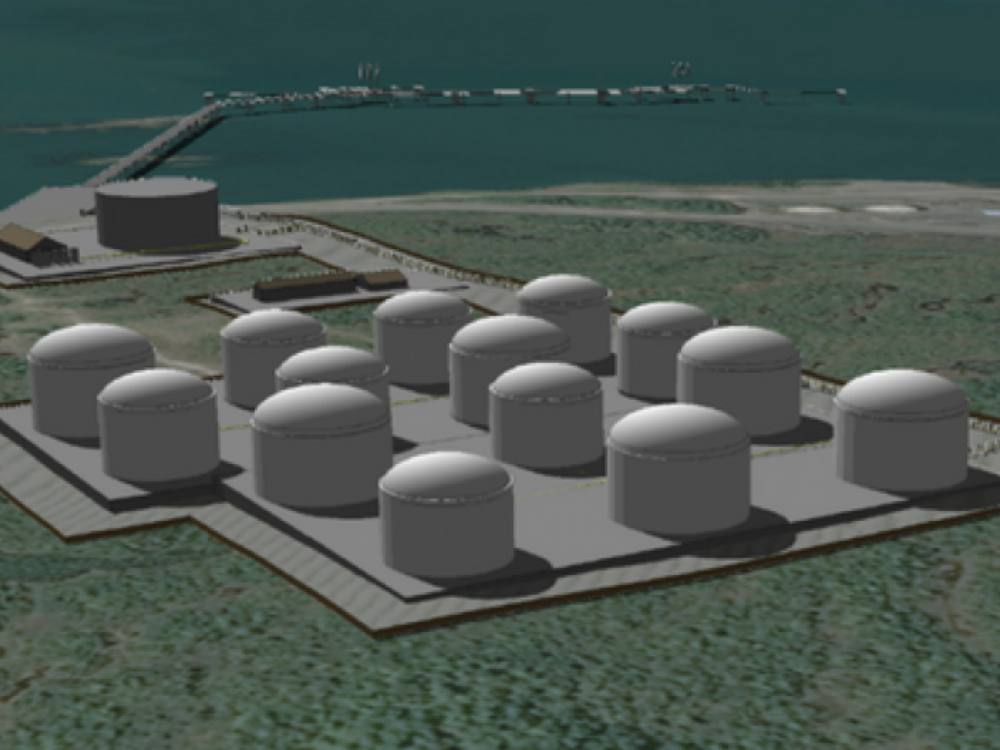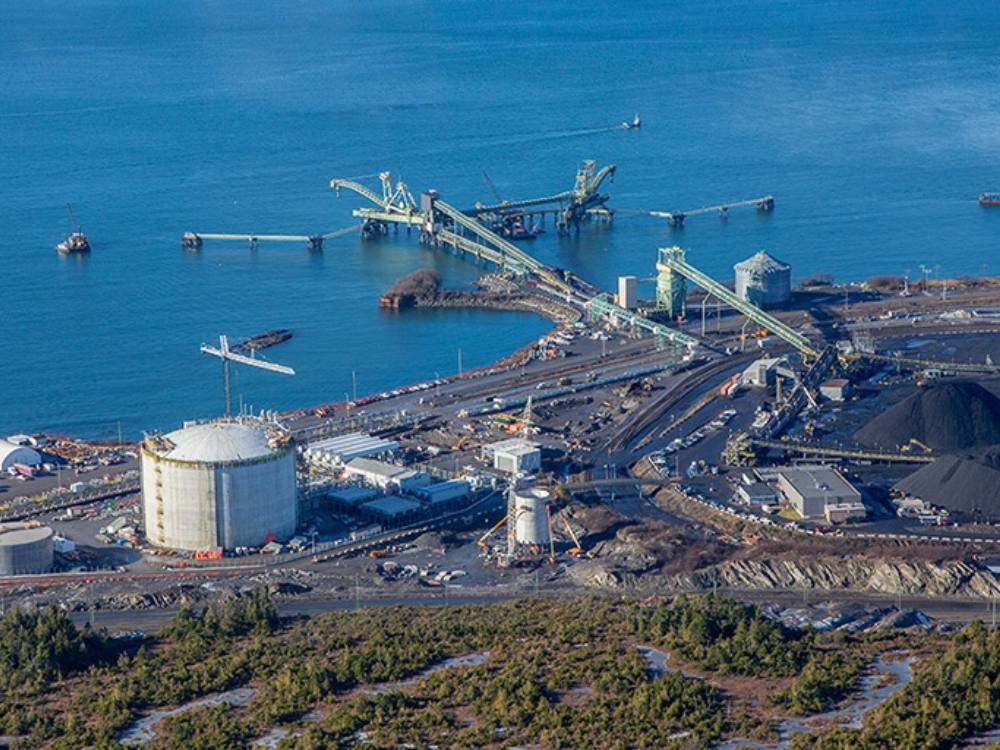The province has approved a fossil fuel storage and shipping facility on B.C.’s north coast despite opposition from First Nations and the potential for “significant” adverse effects in the event of a spill.
The Ministry of Environment and Climate Change announced the decision last week to grant an environmental assessment certificate to Vopak Development Canada Inc., a subsidiary of the Netherlands-based Royal Vopak.
The company plans to build a liquified petroleum gas, methanol, light diesel and gasoline storage facility on Ridley Island near Prince Rupert.
The project still requires federal approvals.
The $900-million facility would bring up to 240 train cars a day carrying liquid fossil fuels from various locations in Western Canada. The products would be loaded onto up to 150 tankers every year.
The government acknowledged significant risks, but said a spill is unlikely.
“The EAO determined there would likely be significant adverse human and environmental effects, should a worst-case scenario involving large spills of liquid petroleum products into the marine environment occur,” it said in the reasons for the decision. “The EAO also concluded that such a spill would be highly unlikely.”
The decision came from both environment and energy ministries.
The proposed site sits near the mouth of the Skeena River, B.C.’s second largest watershed, and overlaps the traditional territories of the Gitga'at, Gitxaała, Kitselas, Kitsumkalum, Metlakatla and Lax Kw’alaams nations. Concerns have been raised over increases in rail and marine shipping, as well as impacts to wild salmon.
In explaining the decision, George Heyman, minister of environment and climate change strategy, and Bruce Ralston, minister of energy, mines and low carbon innovation, repeatedly passed responsibility for outstanding concerns over to the federal government.
It “generally takes the lead” on issues concerning the marine environment and the project is being developed on federal land under jurisdiction of the Prince Rupert Port Authority, they said.
“In our view, this means that, while the [Environmental Assessment] Act applies to projects on federal land like the VPC Project, it cannot be used to prohibit the development of federal property,” it said.
The increase in dangerous goods being shipped by rail is outside the scope of both the federal and provincial assessments, it added.
Vopak said in an update on its website that it continues to work with federal authorities on approvals required under the Canadian Environmental Assessment Act and Impact Assessment Act before making a final investment decision on the project.
“Vopak is pleased to have achieved this milestone and appreciates all the feedback that was provided by the Indigenous nations, members of the working group, and the public throughout the robust provincial process,” the company said.
The provincial approval goes ahead despite an explicit lack of consent from several First Nations impacted by the project, with Gitga’at, Kitsumkalum and Lax Kwa’alaams First Nations, as well as two Wilps, or house groups, within the Gitxsan Nation, expressing outstanding concerns not addressed during the environmental assessment process.
The nations asked the province to delay the approval, but the province said in its decision that it would rely on “Vopak’s commitments to engaging Indigenous nations” and federal requirements to manage the risks.
“We are raising Indigenous nations’ concerns in this regard to the federal government, urging it to consider these issues in the federal determinations,” it said.
According to the decision, the Gitga’at Nation registered its opposition on multiple occasions over the past year, in both writing and in person, saying that consultation had not been sufficiently completed and that it had concerns about health effects, air quality, marine navigation and rail safety, including from “accidents and malfunctions.”
The Gitga’at community of Hartley Bay sits about 120 kilometres south of Prince Rupert and has previously been impacted by fuel leaks from BC Ferries’ Queen of the North, which sank near the community in 2006, and U.S. army vessel Brigadier General M.G. Zalinski, which sank in September 1946 and was linked to a fuel slick in the area a decade ago.

In a 20-page submission sent in October, the nation said it had repeatedly urged the province to hold off on issuing the certificate until consultation had been sufficiently completed.
“Gitga’at is seriously concerned about the EAO’s approach to assessing impacts on our rights,” the letter reads. “In nearly every category of impact considered, the EAO has unilaterally downgraded Vopak’s assessed magnitude of the impact on Gitga’at, without providing any reasonable rationale or explanation for doing so. The EAO assessment is entirely unjustified.
“The ministers should not approve this application until Vopak and EAO have meaningfully consulted with Gitga’at with respect to the project’s impacts and ensured mutually acceptable accommodations.”
The EAO “encouraged Gitga’at and Vopak to continue to work together” to resolve their issues, the ministers noted in their decision.
“The EAO provided its view that Gitga’at has been provided with extensive opportunities to engage directly with the EAO and Vopak,” the decision said, adding that the nation had opportunities to “raise issues regarding assessment methods, information requirements, mitigation measures and assessment conclusions including in relation to the assessment of health effects, risks related to air quality, navigation, accidents and malfunctions and cumulative effects.”
Kitsumkalum, Lax Kw’alaams and Metlakatla nations also did not consent to the project, the province noted, expressing concern over impacts to marine life, fish habitat and the effects of a spill. Kitsumkalum and Metlakatla nations requested that a decision on the project be delayed until their concerns were addressed, it said.
Lax Kw’alaams Nation requested further studies about potential impacts to Flora Bank, a rare eelgrass bed at the mouth of the Skeena estuary that has been described as a critical transition point for young salmon entering the ocean.
Wilp Gwininitxw and Wilp Luutkudziiwus, two Gitxsan Nation house groups whose traditional territory lies upriver within the Skeena watershed, expressed concern about risks to salmon populations in the case of a rail spill and a lack of engagement with the assessment process.
Kitsumkalum Nation, which sits just west of Terrace alongside both the Skeena River and the railway tracks, also expressed concern about increased risks from rail transportation.
But the EAO determined it had met its duty to consult, saying the nations’ concerns “primarily relate to matters best addressed by the federal government due to its powers over navigation, shipping, fisheries, and interprovincial rail transportation.”
The Tyee was not able to reach the Gitga’at, Kitsumkalum, Lax Kw’alaams or Metlakatla nations for comment on the approval, which comes three weeks after B.C. released an action plan for implementing the Declaration on the Rights of Indigenous Peoples Act. The legislation passed in November 2019 and promises to bring the province’s laws into alignment with the United Nations declaration.
A key component of the legislation is the need to obtain free, prior and informed consent from First Nations before making provincial decisions impacting their traditional territories. The act specifically references the need for consent prior to “storage or disposal of hazardous materials” on Indigenous lands.
In an emailed response to The Tyee, a spokesperson for B.C.’s Environment Ministry said the province is committed to implementing the UN declaration and “bringing its principles into action in the context of environmental assessments.” The ministry added that the EAO had consulted with First Nations on the project, seeking to achieve consensus.
“In making their decision, the two ministers considered the potential impacts to First Nations interests, articulated through the assessment report and individual submissions by nations, and met with them to better understand their interests and concerns,” it said, adding that the outstanding concerns related primarily to “matters within federal jurisdiction.”
“The project is required to meet specific conditions and design parameters under the environmental assessment certificate, if it moves ahead,” the province said in a statement. “The ministers have determined that with the certificate’s requirements, significant adverse effects are unlikely to occur with regard to areas under provincial jurisdiction.”
Conditions in granting the certificate include Vopak developing a greenhouse gas emissions reduction plan, working with local communities and First Nations to mitigate potential adverse effects, and working to manage the cumulative effects of other projects in the area.
The province estimated the project’s contribution to greenhouse gas emissions to be “of low magnitude,” according to the decision, at about 0.14 per cent of B.C.’s total 2017 emissions.
The facility is also expected to add 240 railcars a day to a region facing a significant increase in dangerous goods shipped by rail. But provincial regulators determined that the impacts of increased rail traffic were beyond the scope of the project.
“Although increased rail traffic was not part of the EA, for our information the EAO’s Assessment Report includes outstanding concerns identified by Indigenous nations regarding rail transportation,” it said, adding that First Nations, Transport Canada, Prince Rupert Port Authority and CN Rail have formed a group to discuss railway concerns.
“We have written to the federal government strongly urging them to meaningfully address the outstanding issues through the rail dialogue forum,” it added.
Concerns over the increase in dangerous goods by rail through the North have been ongoing for years.
Independent audits in 2020 and 2021 found that a lack of oversight by Transport Canada left railway communities — many of them dependent on volunteer fire departments — vulnerable to the risk of an accident. The audits determined that many issues identified in a similar investigation a decade earlier had not been resolved.
But local residents won’t have the opportunity to voice concerns about increased dangerous goods passing through their communities as part of the federal assessment process.
Taylor Bachrach is the member of Parliament for Skeena-Bulkley Valley and the NDP’s transportation critic. He calls the federal government’s failure to consider the increase in dangerous goods travelling through the North should the Vopak project go ahead “one of the big flaws” in the federal government’s environmental assessment process.
“At a high level, I would say that Canada’s approach to rail safety is a hands-off approach that in many ways allows the big rail corporations to regulate themselves, and that’s deeply concerning for many Canadians,” he said about the recent audits showing the federal government isn’t doing enough to assess the effectiveness of safety management systems.
“The reality here is that there’s no trigger for a proper risk assessment of the dramatic increase in the transport of dangerous goods by rail. That’s a big concern for communities along the corridor because we have more trains, we have longer trains, and we have trains carrying extremely volatile products,” Bachrach said.
“The concerns we’ve heard from communities along the rail corridor have been focused on the increased transport of dangerous goods that the Vopak project will create.”
According to the province, Vopak made “substantive changes” to its project design since the environmental assessment process began in 2018, such as removing dredging from its plans and changing vessel mooring to minimize disturbance of the sea floor.
In granting the certificate, the province noted the project’s economic benefits.
The company estimates that direct expenditures during construction would total $885 million over two years, with approximately 250 full-time equivalent jobs within B.C., 70 of them local.
Direct expenditures during operations would total $29 million per year within B.C. and the creation of roughly 39 jobs, 30 of them local, it added. ![]()
Read more: Indigenous, Energy, Environment

















Tyee Commenting Guidelines
Comments that violate guidelines risk being deleted, and violations may result in a temporary or permanent user ban. Maintain the spirit of good conversation to stay in the discussion.
*Please note The Tyee is not a forum for spreading misinformation about COVID-19, denying its existence or minimizing its risk to public health.
Do:
Do not: